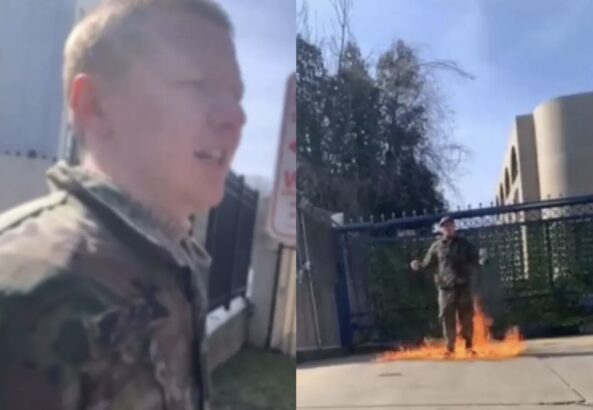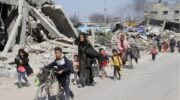In a minimally normal society, Aaron’s words and video of his immolation would be on every major media outlet and there would be thousands outside the genocidal Israeli embassy, shutting it down.
by Sam Husseini, reposted from Husseini substack, February 26, 2024
Update: (A full unedited, graphic video of Aaron Bushnell’s self-immolation (warning: disturbing) is available on his original post, here.)
It’s now 2 a.m. and that’s appropriate, as this piece notes below, after Mohamed Bouazizi’s self-immolation, people were screaming “Dignity! Dignity!” out their windows at 2 a.m.
We should see the gruesome reality of Israel’s horrors and genocide against the Palestinian people. And we should see the agony that a determined Aaron went through to try to end it.
Aaron Bushnell identified himself in the livestream video as he walked toward the Israeli embassy as “an active duty member of the U.S. Air Force” adding that “I will no longer be complicit in genocide.” He then lit himself ablaze and yelled “FREE PALESTINE!” over and over. He has reportedly died.
As he burned up, uniformed personnel screamed at him to get on the ground. One officer has a gun drawn on Aaron until after he collapses.
Finally another officer says: “I don’t need guns, I need fire extinguishers!”
Prior to lighting himself ablaze, Aaron poured liquid from a metal bottle over his head and put on his military cap. He then took out a lighter and struggled to light it.
“I’m about to engage in an extreme act of protest,” he said calmly as he walked to the embassy. “But compared to what people have been experiencing in Palestine at the hands of their colonizers, it’s not extreme at all. This is what our ruling class has decided will be normal.”
The Buddhist monk Thich Nhat Hanh says of self-immolation: “I think we must try to understand those who have sacrificed themselves. … It is done to wake us up.”
But much is done to lull us back to sleep. Big media covered this in a limited capacity and some of it reflected the view that the immolator may have been a danger to others.
CNN quoted an Israeli embassy spokesperson that “no embassy staff were injured and are safe.” The New York Times reported with a straight face “The police also investigated a suspicious vehicle nearby for explosives.” As if Aaron could plausibly be a danger to anyone else.
This is the second self-immolation I know of in the US about Palestine since Israel started its current slaughter. A woman immolated herself in December at the Israeli consulate in Atlanta. I still don’t know her name or even if she survived. She’s an unperson.
In her case, the coverage was probably worse. ABC quoted an Israeli official: “It is tragic to see the hate and incitement toward Israel expressed in such a horrific way.” And, as I say, we still don’t know her name or if she’s dead.
Aaron however livestreamed what he did, making it harder to ignore and memoryhole, else people might have to immolate themselves to get the names of others who have immolated themselves.
Talia Jane, the main source for information on Aaron, posted a still of the immolation, which almost makes it look like he’s smiling as he’s set afire. And she later posted the video, but with the immolation blurred (even thought she had put out a still of the beginning of it; she implied the blurring is what his family wanted; it’s quite clearly not what Aaron wanted.)
While the photo of the Buddhist monk Thich Quang Duc immolating himself helped wake people up about oppression of the US-backed South Vietnamese government, the blurred out image of Aaron’s self-immolation will clearly help lull people to sleep about Israel’s US-backed genocide.

We apparently are to only see violence when it’s fictionalized and if we pay Hollywood for the pleasure. Reality is off limits.
In a minimally normal society, Aaron’s words and video of his immolation would be on every major media outlet and there would now be thousands outside the genocidal Israeli embassy, completely shutting it down.
When Mohamed Bouazizi immolated himself in Tunisia, it helped spark the Arab uprisings of 2011. While Bouaziz lay in the hospital, people in Tunisia could hear their neighbors shouting from their windows “Dignity! Dignity!” at 2:00 a.m.
Immolators in the US have not been so lucky.
Years ago, I wrote a piece about Gregory Levey, who immolated himself to try to stop the 1991 Iraq War. I lamented how he was ignored while Bouazizi wasn’t.
I got a note from Brian Willson, who was affected by Norman Morrison’s immolation in on Nov. 2, 1965 within view of Robert McNamara’s Pentagon office window.
Brian told me there were others who immolated themselves in opposition to the first Iraq War whom I’d never heard of:
I have only a small amount of info about Timothy T. Brown. I have virtually nothing about Raymond Moules.
Brown was 48, a Viet Nam veteran, who had a local knife sharpening business serving restaurants working out of his van but lived on a houseboat near Isleton, CA, a tiny fishing village on the Sacramento-San Joaquin Delta, about 70 miles northeast from San Francisco.
He was considered a quiet, but upbeat kindly man who was not thought of as having any specific politics. But he did leave a note:
“I, Tim Brown, Vietnam veteran, declare that my act of self-immolation is a direct protest of American war policy in the Middle East…America, do not go to war. America, do not repeat the mistake of Vietnam. Don’t wait for the war to start and then protest. Protest now while there is still time.”
His immolation occurred on Sunday, December 9, 1990 in Isleton.
Raymond Moule’s immolation occurred in Springfield, MA, Thursday, February 21, 1991. He was 33 years old. I could find no other info about him.
One remarkable thing about Aaron is that he was active military.
Lots of vets kill themselves.
Quietly.
Tragically.
Aaron at least brought his grievance to the doorstep of criminals rather than die alone in quiet desperation.
His extreme measures show how people have no voice:

And military personnel may be especially constrained:

Brian wrote to me: “One could argue that immolations are like distressed canaries … We live in a pathological culture operating as a criminal psychopath, way out of control headed for annihilation.”
In November 2006 musician Malachi Ritscher immolated himself in Chicago. “Maybe some will be scared enough to wake from their walking dream state” he wrote. “When I hear about our young men and women who are sent off to war in the name of God and Country, and who give up their lives for no rational cause at all, my heart is crushed. … Half the population is taking medication because they cannot face the daily stress of living in the richest nation in the world…. The violent turmoil initiated by the United States military invasion of Iraq will beget future centuries of slaughter, if the human race lasts that long.” I recall being appalled by the lack of media coverage of Ritscher’s death. Even programs like Democracy Now wouldn’t mention it.
Aaron’s empathy with the Palestinian people is profound.
And it comes from a similar longing.
As I wrote in the piece below: “A refusal to live in permanent subjugation — a liberty though death — and a hope that by exiting that subjugation though death, a dignified life might be achieved for others who one loves.”
It’s way past time to Wake Up.
Interesting recent piece by Miguel A. Cruz Díaz: “On the Shame of Living Through Times of Genocide”.
Sam Husseini is a Jordanian-Palestinian writer and political activist. He is the communications director of the Institute for Public Accuracy, a D.C.-based nonprofit group that promotes progressive experts as alternative sources for mainstream media reporters. He formerly worked at the American-Arab Anti-Discrimination Committee and at the media watch group Fairness and Accuracy in Reporting. Husseini has written articles for a variety of publications, including CounterPunch, The Nation, The Washington Post, USA Today, and Salon.
FOR BACKGROUND, READ:





